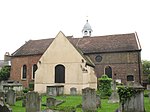The Star and Garter Hotel in Richmond was a hotel located in the London countryside (later suburbs) on Richmond Hill overlooking the Thames Valley, on the site later occupied by the Royal Star and Garter Home, Richmond. The first establishment on the site, an inn built in 1738, was relatively small. This was followed by several other buildings of increasing size and varied design as the site changed from family ownership to being run by a limited company. Some of the rebuilding or extension work took place following fires that by 1888 had destroyed most of the original buildings. At various times architects were commissioned to build grand new buildings or extensions to take advantage of the famed view over the river and valley below, with the largest being the 1860s chateau block by E. M. Barry.
The hotel reached the peak of its fame as Richmond itself expanded in the 19th century during the Victorian era. In the period from the 1830s to the 1890s, the hotel guests ranged from literary figures such as Charles Dickens to exiled crowned heads of Europe such as King Louis-Philippe and his wife. The hotel's reputation spread to other countries, with guests arriving from the USA and Europe, or travelling by horse and carriage from London to visit the area and stay at the hotel. In the later years of the 19th century, the hotel and its concert hall, banquet hall, and gardens were used for public dinners, fetes and fundraising gatherings, often attended by local grandees and members of the royal family.
Following the end of the Victorian era, the rise of the motor car and more widespread travel led to a decline in the hotel's fortunes, and it failed twice to be sold at auction. During World War I it was purchased by the Auctioneers and Estate Agents Institute and donated to Queen Mary in 1916 in support of her plans to establish a home for paralysed and permanently disabled soldiers. The hotel buildings were demolished and rebuilt as a care home beginning in 1919; the new building was dedicated in 1924 as the Women of the Empire's Memorial of the Great War.










